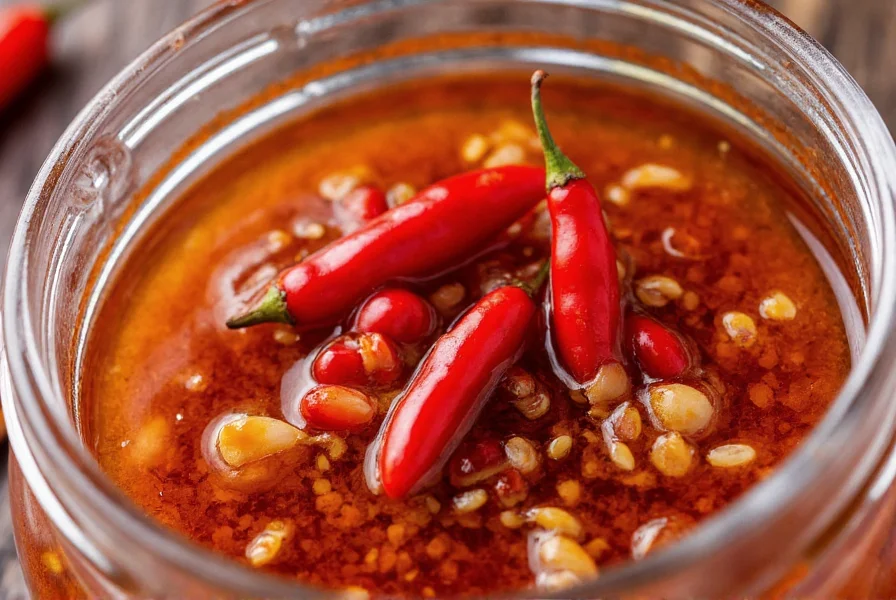Originating in China's Sichuan province, chili crisp has evolved from regional specialty to global pantry staple. The condiment's journey began as a traditional method of preserving chili peppers through oil infusion, a technique developed to extend shelf life while enhancing flavor. Sichuan cuisine's signature mala (numbing-spicy) profile comes from the combination of dried chilies and Sichuan peppercorns, which create a unique tingling sensation alongside heat.
Understanding Chili Crisp Composition
Authentic chili crisp contains several key components that differentiate it from simpler chili oils:
- Fried aromatics: Garlic, shallots, or onions fried until golden
- Dried chilies: Typically a blend of mild and hot varieties
- Sichuan peppercorns: For characteristic numbing sensation
- Fermented elements: Black beans, doubanjiang, or fermented soybeans
- Aromatic oil: Usually soybean or vegetable oil infused with spices
- Sesame seeds: For texture and nutty flavor
The magic happens during the slow cooking process where ingredients are fried at precise temperatures to extract maximum flavor without burning. This careful preparation creates layers of flavor that simple chili oils lack. Unlike sriracha or Tabasco, chili crisp offers both liquid and crunchy components, providing textural contrast that enhances dishes.

Chili Crisp vs Similar Condiments
Many confuse chili crisp with other Asian condiments, but key differences exist:
| Condiment | Texture | Primary Ingredients | Flavor Profile |
|---|---|---|---|
| Chili Crisp | Crunchy with solid pieces | Fried chilies, garlic, Sichuan peppercorns, fermented beans | Complex umami, moderate to high heat, numbing sensation |
| Chili Oil | Smooth liquid | Chili flakes infused in oil | Primarily heat with minimal complexity |
| Sriracha | Smooth sauce | Chili, vinegar, sugar, garlic | Spicy, tangy, sweet |
| Doubanjiang | Paste-like | Fermented broad beans, chilies | Salty, funky, moderately spicy |
Practical Applications in Cooking
Chefs and home cooks value chili crisp for its versatility. The sauce enhances dishes through multiple applications:
Direct Enhancement
Add straight from the jar to finished dishes for instant flavor boost. Popular uses include:
- Stir-fried vegetables (add during last minute of cooking)
- Noodle dishes (toss with cooked noodles and sauce)
- Rice bowls (swirl into steamed rice)
- Avocado toast (elevates simple breakfast)
- Scrambled eggs (mix in before cooking)
Culinary Base Ingredient
Incorporate chili crisp as foundational flavor in recipes:
- Marinades for proteins (combine with soy sauce and honey)
- Soup bases (add to broths for depth)
- Dipping sauces (mix with vinegar and sesame oil)
- Baking applications (surprisingly works in chocolate desserts)

Storage and Shelf Life Considerations
Proper storage maintains chili crisp's quality and safety:
- Store unopened jars in cool, dark pantry for up to 18 months
- Refrigerate after opening to preserve freshness (6-12 months)
- Always use clean, dry utensils to prevent contamination
- Oil may solidify when refrigerated - return to room temperature before use
- Separation is normal - stir well before each use
Homemade versions have shorter shelf life (3-4 weeks refrigerated) due to lack of preservatives. Commercial products often contain natural preservatives like citric acid to extend freshness without artificial additives.
Creating Authentic Homemade Chili Crisp
While store-bought options provide convenience, homemade chili crisp allows customization. The basic process involves:
- Preparing ingredients: finely chop dried chilies, mince garlic and shallots
- Heating oil to precise temperature (300-325°F)
- Frying aromatics in sequence based on cooking time requirements
- Adding spices and fermented components
- Cooling and storing in sterilized jars
Key to success is controlling oil temperature - too hot burns ingredients, too cool creates greasy texture. Many home cooks start with a base recipe then adjust heat level and ingredients to personal preference. Adding ingredients like black cardamom or star anise creates regional variations authentic to specific Chinese culinary traditions.
Frequently Asked Questions
Is chili crisp sauce vegan friendly?
Most commercial chili crisp varieties are vegan, containing only plant-based ingredients like chilies, garlic, oil, and spices. However, some premium versions may include shrimp or other seafood elements. Always check the ingredient list if following strict vegan guidelines, as formulations vary between brands and regional versions.
How spicy is traditional chili crisp compared to other hot sauces?
Chili crisp typically ranges from moderate to high heat (2,000-15,000 Scoville units), generally milder than habanero-based sauces but spicier than many chili garlic sauces. The heat builds gradually rather than hitting immediately, and the numbing effect of Sichuan peppercorns creates a different sensation than capsaicin-heavy sauces. Many brands offer mild versions specifically for those sensitive to spice.
Can I substitute chili crisp in recipes calling for chili oil?
Yes, but with adjustments. When substituting chili crisp for chili oil, use about half the amount since chili crisp contains solid ingredients that concentrate flavor. For recipes requiring only the oil component, gently heat the chili crisp and skim off the top oil layer. Remember that chili crisp adds texture and additional flavors beyond simple heat, which may alter the dish's intended profile.
Does chili crisp need refrigeration after opening?
Yes, refrigeration after opening significantly extends freshness and prevents spoilage. While the high oil content provides some preservation, refrigeration maintains optimal flavor for 6-12 months. Without refrigeration, opened chili crisp may develop off-flavors within 1-2 months. The oil may solidify when cold but returns to liquid state at room temperature without affecting quality.
What are traditional Chinese dishes that feature chili crisp?
In Chinese cuisine, chili crisp traditionally enhances dishes like dan dan noodles, mapo tofu, and steamed fish. Sichuan chefs use it as finishing oil for boiled vegetables (diy di gua), stir-fried meats, and as dipping sauce for dumplings. Street food vendors incorporate it into rice cakes and skewered foods. Modern applications have expanded far beyond traditional uses, with chefs worldwide experimenting with chili crisp in unexpected dishes from pizza to ice cream.











 浙公网安备
33010002000092号
浙公网安备
33010002000092号 浙B2-20120091-4
浙B2-20120091-4